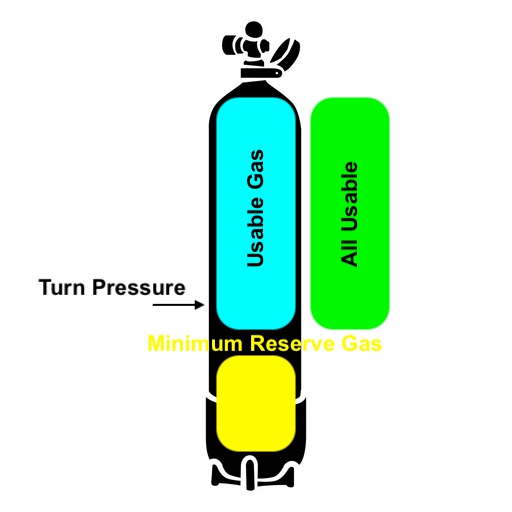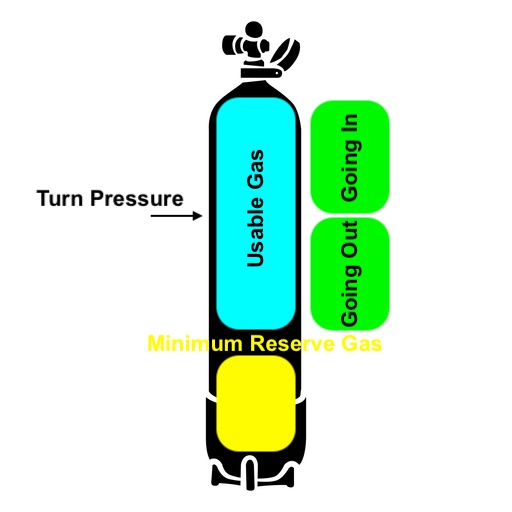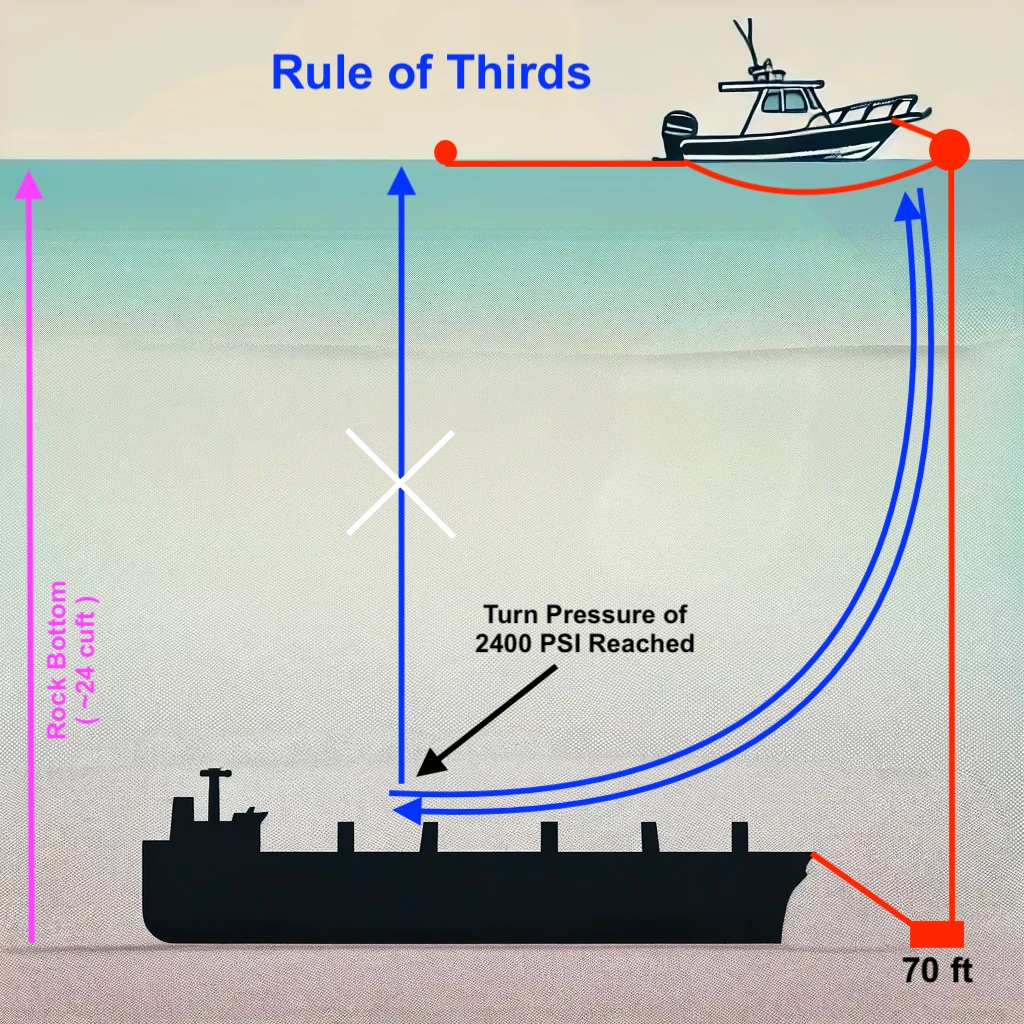- Back on the boat with 500psi - No plan...just tool around until you run out of gas
- All Usable - You can surface whenever you want
- Rule of Halves - You prefer to return to some specific point to surface
- Rule of Thirds - You must return to some specific point to surface
As a recreational diver you will generally use either "All Usable" or "Rule of Halves". It would be a very rare occurance where Rule of Thirds would be preferred.
Turning the Dive
As part of your dive planning, or at least the pre-dive check with your buddy(ies), one of the absolute key things to discuss and agree on is when will the dive be over and we need to start heading back or ascending...known as "turning the dive". You can figure out the pressure at which you must turn the dive by using one of these gas planning calculations.All Usable
If there are no overhead concerns, be they hard (cave or wreck) or virtual (boat traffic) and you can surface at any point of the dive...then this is generally the gas plan you want. Most common for quarry or lake dives where a surface swim back to the water exit point is immaterial and there are no large boats to worry about.Example using 0.75 RMV, a max depth of 70ft and everyone is using a single Aluminum 80 tank of air...
Step 0: Determine which method of calculating Minimum Reserve Gas you are going to use. (We will use CAT for this example)
Step 1: Determine Minimum Reserve Gas which is 25cft or 1000 PSI
Step 2: Subtract 1000 PSI from the working pressure of the AL80 tank (3000 PSI) we get 2000 PSI Total Usable Gas
Step 3: Subtract 2000 PSI Usable Gas from the working pressure of the AL80 tank (3000 PSI) we get 1000 PSI Turn Pressure
Decision: The first diver in the group to reach 1000 PSI will signal to end the dive and begin our ascent


Rule of Halves
If there are overhead concerns or you need/want to ascend at a specific point (such as an anchor or downline) but in an emergency you could surface directly...then this is generally the gas plan you want.Example using 0.75 RMV, a max depth of 70ft and everyone is using a single Aluminum 80 tank of air...
Step 0: Determine which method of calculating Minimum Reserve Gas you are going to use. (We will use CAT for this example)
Step 1: Determine Minimum Reserve Gas which is 25cft or 1000 PSI
Step 2: Subtract 1000 PSI from the working pressure of the AL80 tank (3000 PSI) we get 2000 PSI Total Usable Gas
Step 3: Divide 2000 PSI in half (the entire point of rule of halves) we get 1000 PSI as Actual Usable Gas
Step 4: Subtract 1000 PSI Usable Gas from the working pressure of the AL80 tank (3000 PSI) we get 2000 PSI Turn Pressure
Decision: The first diver in the group to reach 2000 PSI will signal to turn the dive and we are to proceed to the agreed ascent point


Rule of Thirds
If there are overhead concerns or you must ascend at a specific point (such as an anchor or downline) and in an emergency you can not surface directly...then this is generally the gas plan you want. Note, this should not usually be the case for recreational dives. You must not only have enough gas to ascend, you must also have enough gas to get your buddy back to the ascent point. Which means on a single tank, you may have very little gas to use on your dive. And this is one of the reasons that as a recreational dive you do not want to use this gas planning method if there are other options. There is also not just one way to do "rule of thirds". It depends on what you are doing and why.This is the method described in the UTD YouTube video linked above and is the method that most closely matches the prior methods.
Example using 0.75 RMV, a max depth of 70ft and everyone is using a single Aluminum 80 tank of air...
Step 0: Determine which method of calculating Minimum Reserve Gas you are going to use. (We will use CAT for this example)
Step 1: Determine Minimum Reserve Gas which is 25cft or 1000 PSI
Step 2: Subtract 1000 PSI from the working pressure of the AL80 tank (3000 PSI) we get 2000 PSI Total Usable Gas
Step 3: Divide 2000 PSI by 3 (the entire point of rule of thirds) we get ~600 PSI as Actual Usable Gas
Step 4: Subtract 600 PSI Usable Gas from the working pressure of the AL80 tank (3000 PSI) we get 2400 PSI Turn Pressure
Decision: The first diver in the group to reach 2400 PSI will signal to turn the dive and we are to proceed to the agreed ascent point


Option 2 - no Minimum Gas Reserve
Example using 0.75 RMV, a max depth of 30ft and an average depth of 15ft and everyone is using a single Aluminum 80 tank of air...
Step 0: No ascent, so no Minimum Gas Reserve
Step 1: Divide 3000 PSI by 3
- 1000 PSI of gas for going in
- 1000 PSI of gas for going out
- 1000 PSI for our reserve gas (the going out for our buddy)
Decision: The first diver in the group to reach 2200 PSI will signal to turn the dive and we go back to where we went in
But..but..that's horrible! 800 PSI is nothing! Do not forget the depth we are talking about here...800 PSI at 15ft average depth with an RMV of 0.85 will last roughly 55 minutes. That's a GREAT dive on a single tank. But would be practically useless on a dive to 100ft.
Putting it all together
Once you know your RMV and your Rock Bottom or Minimum Reserve Gas it is super simple to calculate what your turn pressure should be. And once you have calculated this once, it is a great thing to have in a Wetnote or part of your dive kit for doing planning. It would look something like....
